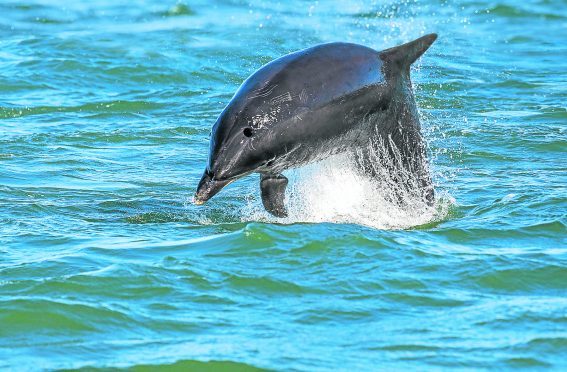Maybe I had more in common with dolphins than I thought as I stared out at the North Sea through streaming eyes and dripping nose with a bitter wind whipping my face mercilessly.
I was straining to see the next dorsal fin cutting effortlessly through the water in anticipation of enjoying another big leap. Or “breach” as professional dolphin watchers like to call these amazing displays of acrobatics.
The process has a kind of addictive feel to it. You can’t drag yourself away for fear of missing something spectacular.
“Triple breach, triple breach!” someone shrieked.
It sounded painful. Was there a first-aider around, I wondered.
But it meant three dolphins had jumped in unison.
Heads swerved frantically, but as usual I was looking the wrong way.
Ahead of the doom-laded UN report in Paris a few days ago warning that nature and many species on land and sea were disintegrating at the dangerous hands of man, I got myself down to Aberdeen harbour entrance to check-up on the famous bottleneck dolphins which regard this spot as their favourite fast-food place.
I was huddling under an awning set up by a small dedicated group of staff and volunteers with RSPB, which is running its annual public Dolphin Watch from a vantage point above the harbour at Torry Battery.
This impressive former military lookout position which boasted heavy defensive guns is of great historical importance, but appears sadly neglected.
The dolphin watchers had fixed the awning pretty well as it withstood everything the wind could throw at it. When the wind realised it couldn’t blow that down, it turned its attention to playing havoc with their dolphin information leaflets instead.
They were blown about like confetti and our hardy little group scrabbled around to retrieve them.
The camaraderie was all very British – stoic and cheerful to the core in spite of being battered by nature. One of the friendly staff was handing out millionaire’s chocolate mini-bites she had brought along and we munched our way through them while gazing at a whirl of fins, flukes and flippers just yards away.
These particular dolphins are a magnet for nature tourists from around the world due to their easy-to-see proximity, but do locals take them for granted? Could we lose them to climate change and man’s carelessness?
The dolphins and I do have something in common after all: they swim for fun as well as necessity, and they love eating as much salmon, mackerel, bass and trout as they can get.
The team showed me a book in which they log and identify some of this dolphin community – now numbering 210 cruising daily between Moray and the north-east – by their unique fin markings. They even have names. I took an instant liking to one called Pizza.
I noticed what looked like a bazooka poking about in the undergrowth nearby and discovered it was a large telephoto lens attached to a keen and affable wildlife photographer.
He scrambled out a few minutes later to share a joyous picture with us which he had just taken – a dolphin mum swimming in harmony with its baby calf. Not exactly a royal baby, but an image which gives us hope for the future of marine nature.
But with a possible lifespan of decades, what kind of future will it have without our direct intervention?
I gazed into the distance at a cluster of offshore wind turbines – the ones Donald Trump was so angry about because they spoiled the view for his golfers – ringed by harbour-bound ships. Huge works are also going on at the Aberdeen harbour expansion nearby.
Despite efforts to nullify marine damage, they all pose challenges for wildlife from human activity. Erosion of sea life is often an early warning of things going wrong – likened to “a canary in a mine”.
An example of the type of human misbehaviour highlighted by the UN was just yards away behind our backs at Torry Battery.
On today’s date in 1940, also a Monday as it happens, war leader Winston Churchill delivered his “blood, toil, tears and sweat” speech to warn of the British fight for survival against Hitler’s invasion threat.
A year later two soldiers were killed at Torry Battery after direct hits from the Luftwaffe.
It was rightly declared a listed ancient monument nearly 20 years ago to offer some form of protection.
You wouldn’t think it after I had a look around: discarded paint pots, paint daubed on walls and mountains of the usual human debris in partially walled-off bunkers – mainly discarded cans and bottles of booze.
Sadly, it is also a monument to human carelessness, neglect and official complacency.
It doesn’t take much for this potential dangerous rubbish to end up in the sea.
Get your kids out to see the dolphins along our coasts (and any rubbish nearby) for a dose of reality. This is not the make believe in their video games or films. We don’t want to end up in a situation where the only dolphins we see are in animated cartoons because all the real ones are extinct.
David Knight is the long-serving former deputy editor of the Press and Journal

